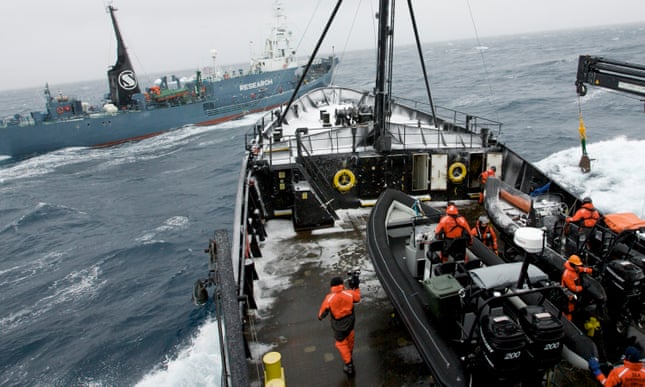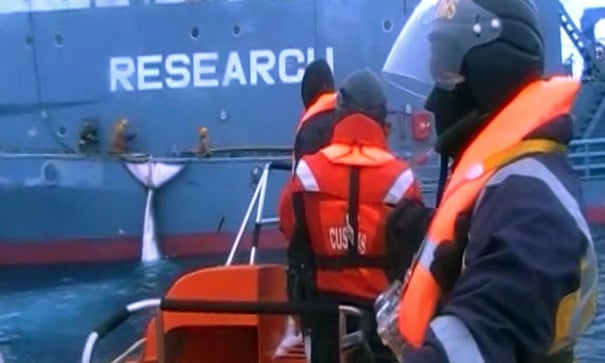January 5th, 2018
A fleet of Japanese ships is currently hunting minke whales in the
Southern Ocean. It is a politically incendiary practice: the waters
around Antarctica were long ago declared a whale sanctuary, but the
designation has not halted Japan’s whalers, who are continuing a
tradition of catching whales “for scientific research” in the region.
In the past, conservation groups such as Sea Shepherd have mounted
campaigns of harassment and successfully blocked Japan’s ships from
killing whales. But not this year. Despite previous successes, Sea
Shepherd says it can no longer frustrate Japan’s whalers because their
boats now carry hardware supplied from military sources, making the
fleet highly elusive and almost impossible to track. As a result the
whalers are – for the first time – being given a free run to kill minke
in the Southern Ocean.
“We have prevented thousands of whales from being killed in the past
and we have helped ensure that the quota of minkes that Japan can take
now is much lower than in the past,” said Peter Hammarstedt, a Sea
Shepherd captain.

Japan is not the only nation to hunt whales. Norway has a commercial operation in its own waters, for example. But what infuriates conservationists is that Japan is hunting and killing whales in a conservation zone, the Southern Ocean whaling sanctuary, that surrounds Antarctica. Japan claims that it does so only for scientific purposes.
“Essentially, they are exploiting a loophole in the rules – introduced in the 80s – that govern the banning of commercial whaling,” said Paul Watson, the founder of Sea Shepherd.
Originally Japan set out to catch more than 900 minkes every year, as well as 50 humpbacks and 50 fin whales. However, its fleet was rarely able to reach these quotas because of actions by groups like Sea Shepherd. “We physically got in between the whalers and the whales and stopped the latter being killed,” said Hammarstedt. “One year we stopped Japan getting all but 10% of its quota. Their ships were nearly empty when they got back home.”
Then, a few years ago, the International Court of Justice – at the instigation of Australia and New Zealand – ruled that the country’s whaling plan had no scientific basis. Japan was forced to halt whale hunting and had to come back with a plan to carry out “scientific whaling” in the region. This now involves catching only 330 minkes, and no humpbacks or fin whales. It was an important victory for conservationists.
But, crucially, the Japanese also doubled the area of the Southern Ocean from which they said they would seek whales, and that has made it much harder to block their hunting. “It is simply a lot more difficult to find the whaling fleet in a much larger area of sea,” said Hammarstedt.

As a result, Sea Shepherd has decided not to send a vessel to try to interrupt Japan’s whaling efforts this year. “We have an obligation to our supporters that if we cannot be successful in intervening directly, then it would not make sense to send a vessel,” said Watson.
Hammarstedt agreed. “We were active in the Southern Ocean for 10 years and saved more than 6,000 whales. We also have many other critically important campaigns to run elsewhere in the world.”

“The Japanese get so much of their protein from fish and other marine creatures – and that dependency worries their government,” said Watson. “It fears that, if it gives in to calls for a ban on whaling, that will be seen as an admission that the international community can dictate what Japan can and cannot do at sea.”
In other words, Japan worries that conservationists would then move on to other major marine issues – such as the bluefin tuna, another threatened species, which the Japanese catch and consume in large numbers.
“Japan does not want anyone else to have influence on its marine policy and as a result has followed a practice of voting down anything and everything to do with conservation at sea,” added Hammarstedt.
There are other issues. Shinzo Abe, the Japanese prime minister, is a conservative and a nationalist, and is opposed to giving way to other nations over traditional issues, say observers. They point out that Abe has tried to turn the catching of whales into a nationalist concern by claiming it is a cultural topic unique to Japan and should be given special international status.
The ministry of fisheries in Japan is also very powerful and the Institute of Cetacean Research, which carries out the “scientific whaling” in the Southern Ocean, is part of that ministry. “Its bureaucrats are very senior and very influential,” added Hammarstedt. “They tend to get their way.”
And then there is the issue of the Antarctic Treaty which strictly controls how the continent and its waters are exploited. That treaty does not expire until 2048. But if Japan maintains a presence in Antarctic waters it could make a claim to be allowed greater influence in the region when a new treaty is negotiated by world powers.
“This has become quite an issue for Japan,” said Watson.
This article was first published by The Guardian on 23 Dec 2017.











Đăng nhận xét